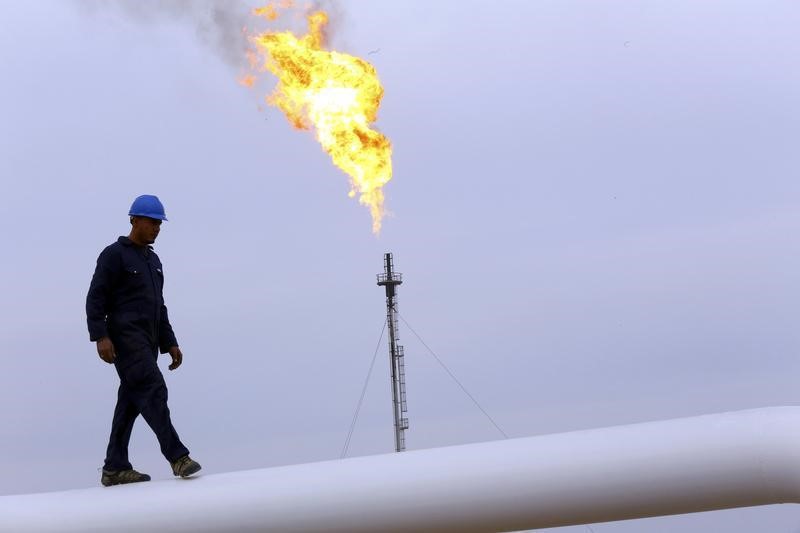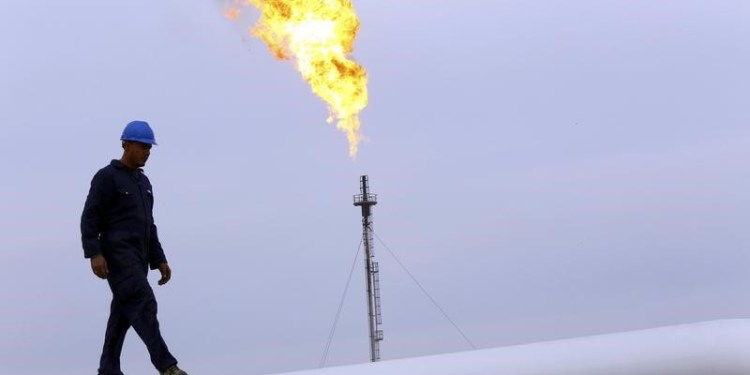
© Reuters.
LCO
+0.23%
Add to/Remove from Watchlist
Add to Watchlist
Add Position
Position added successfully to:
Please name your holdings portfolio
Type:
BUY
SELL
Date:
Amount:
Price
Point Value:
Leverage:
1:1
1:10
1:25
1:50
1:100
1:200
1:400
1:500
1:1000
Commission:
Create New Watchlist
Create
Create a new holdings portfolio
Add
Create
+ Add another position
Close
CL
+0.26%
Add to/Remove from Watchlist
Add to Watchlist
Add Position
Position added successfully to:
Please name your holdings portfolio
Type:
BUY
SELL
Date:
Amount:
Price
Point Value:
Leverage:
1:1
1:10
1:25
1:50
1:100
1:200
1:400
1:500
1:1000
Commission:
Create New Watchlist
Create
Create a new holdings portfolio
Add
Create
+ Add another position
Close
Investing.com – Crude prices jumped almost $2 a barrel Tuesday before giving back everything to settle a touch lower as warnings of an overbought market led to profit-taking and tempered some of the bull mania of the past three weeks driven by just one thing: notion of tight supply.
New York-traded West Texas Intermediate, or WTI, crude for delivery in November settled Tuesday’s trade at $90.48 per barrel, down 10 cents on the day. The U.S. crude benchmark rose to $92.41 earlier in the session, its highest since November 2022. Last week, WTI finished up 3.7%, adding to prior back-to-back weekly gains of 2.3% and 7.2%.
London-traded Brent settled at $94.34/bbl, down 9 cents, 0.1%. The global crude benchmark hit a 10-month high of $95.94 earlier on Tuesday. Brent finished last week up 3.6%, adding to prior back-to-back weekly gains of 2.4% and 4.8%.
Crude prices have been on a tear since early June, with the rally accelerating in the past three weeks after major oil exporters Saudi Arabia and Russia colluded to remove a combined 1.3 million barrels from the market each day until the end of the year.
Adding to concerns over supply, U.S. oil production from top shale-producing regions could drop to 9.393 million barrels per day in October from 9.433 million barrels in September — to reach the lowest levels since May, a government report said.
$90 price “looks unsustainable” – Citi’s Ed Morse
While the Saudi-Russian cuts and other production reductions would remove a total of about 3.0 million barrels from supply — or about 3% of daily requirement — some who follow the trade warn that inflationary pressure brought on by oil’s 30% rally over just three months could do the market in.
“The Saudi appetite to withhold oil from market, supported by Russia maintaining a certain level of export constraint, points to higher prices in the short term, all else equal, but $90 prices look unsustainable given faster supply growth than demand growth ex-Saudi/Russia,” Citi’s global head of commodity research Ed Morse and his team wrote to investors.
“Higher prices in the near term could make for more downside for prices next year,” he added.
RBC Capital Markets also referred to the hype over triple-digit pricing that had gripped the market and was now pushing it towards that end, as some sort of self-fulfilling prophecy.
“The notion of $100/bbl has evolved from completely unimaginable a few short months ago, to within striking (or hyping) distance today,” analysts Michael Tran and Helima Croft wrote in a recent note to investors.
Bjarne Schieldrop, Chief Commodity Analyst at SEB, added: “The Chinese property market is struggling and global PMIs have been downhill since mid-2021 with many countries now contracting, sub-50 level. A deep concern for the health of the global economy and oil demand going forward is absolutely warranted. However, killing the global economy off while it is wobbling with an oil price of $110-$120 per barrel or higher is, of course, not a smart thing to do either.”
Tuesday’s price reversal came ahead of two other developments: a Federal Reserve update on monetary policy and weekly U.S. oil inventory data.
Fed verdict on inflation Wednesday
The Fed’s policy-makers aren’t expected to raise interest rates when they meet on Sept. 20, after 11 hikes that added 5.25 percentage points to a base rate of just 0.25% in February 2022.
But what Chairman Jerome Powell says at his news conference on Wednesday will be closely watched for clues on Fed think for the rest of the year, especially with two more policy meetings on the schedule for November and December.
For context, the headline reading for the U.S. Consumer Price Index rose for the second month in a row in August, reaching a year-on-year growth of 3.7% from 3.2% in July.
That was largely due to high pump prices of gasoline which accounted for more than half of the increase — a phenomenon that could put renewed pressure on inflation fighters at the Fed. The central bank’s desired inflation remains at a max 2% per year and it has vowed to get there with more rate hikes if necessary.
Beyond the Fed, markets are also awaiting rate decisions from the Bank of England, the People’s Bank of China and the Bank of Japan this week.
The BOE is expected to hike interest rates by 25 basis points, while the PBOC and the BOJ are expected to keep rates on hold. But any signals on future policy, particularly from the BOJ, will be in focus, given that several members of the Japanese central bank flagged a potential end to its negative rate regime.
In China, the PBOC is expected to keep its loan prime rates on hold as it struggles to strike a balance between supporting an economic recovery and preventing further weakness in the yuan.
The pivotal week for global central banks comes after the ECB raised rates by 25bps last Thursday, bringing its benchmark rate to an all-time high of 4.50%.
U.S. weekly inventories awaited
On the oil inventory front, market participants were on the lookout for an update on weekly U.S. oil stockpiles, due after market settlement from API, or the American Petroleum Institute.
The API will release at approximately 16:30 ET (21:30 GMT) a snapshot of closing balances on U.S. crude, gasoline and distillates for the week ended Sept. 15 The numbers serve as a precursor to official inventory data on the same due from the U.S. Energy Information Administration on Wednesday.
For last week, analysts tracked by Investing.com expect the EIA to report a crude stockpile build of 0.25 million barrels, versus the 3.954M barrel rise reported during the week to Sept 8.
On the gasoline inventory front, the consensus is for a build of 1.1M barrels over the 5.560M-barrel gain in the previous week. Automotive fuel gasoline is the No. 1 U.S. fuel product.
With distillate stockpiles, the expectation is for a climb of 1.05M barrels versus the prior week’s build of 3.931M. Distillates are refined into heating oil, diesel for trucks, buses, trains and ships and fuel for jets.
(Peter Nurse contributed to this item)
Source: Investing.com



























